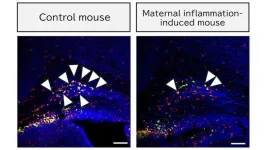(Press-News.org) The ability to predict wildfires - such as those that recently devastated Los Angeles and Canada - is advancing rapidly with the help of ML–driven high-quality data. A new paper, published today (Tuesday 1 April, 16:00 BST | https://www.nature.com/articles/s41467-025-58097-7) in Nature Communications, highlights how the collection and integration of higher-quality data can significantly improve the accuracy and reliability of wildfire predictions.
The paper evaluates how ECMWF's new data-driven fire danger forecasting model, the Probability of Fire (PoF), performed in 2023 and in recent extreme events. ECMWF has been producing fire danger forecasts since 2018 as part of the Copernicus Emergency Management Service(CEMS) led by the Joint Research Centre of the European Commission. In recent years, it has developed innovative approaches using machine learning methods. This effort has moved ECMWF from predicting fire danger – a measure of landscape flammability – to forecasting fire activity. These new products are distributed to the Copernicus Emergency Management Service, and accessible to ECMWF Member States.
“Wildfire prediction as a field of research has been active for decades, which led to the establishment of early warning systems in the 1970s,” explains lead author Dr Francesca Di Giuseppe. “Our new Probability of Fire model incorporates multiple data sources beyond weather to refine predictions. Thanks to a machine learning algorithm, it takes a more holistic approach. Traditional weather-based fire danger indices often fail to pinpoint areas at risk of ignition with enough specificity. This is where ML can help.”
She explains that in the case of the Los Angeles fires, for example, traditional weather forecasts identified broad areas as very flammable but did not accurately target the most probable ignition hotspots. However, by incorporating additional parameters beyond weather - such as human presence, development indices such as road density, and most importantly vegetation abundance and its dryness, Dr Di Giuseppe says by being able to spot the most likely area to experience ignition this helps avoid over-predicting and provides a more accurate and targeted fire risk. “Being able to add all these elements with ML helps refine predictions. For example, we can exclude areas that are hot and dry but unlikely to experience ignition - either because people are not present or there is no fuel to burn,” states Di Giuseppe.
This comprehensive approach has proven to be more accurate in identifying fire-prone areas, as evidenced by the Southern California fire danger forecast for 7 January 2025. In this event, leveraging this Probability of Fire model was able to provide a far more localised and accurate assessment of high fire danger in areas where fires occurred than the traditionally used Fire Weather Index. By accounting for additional parameters, the model captured the intricate dynamics that drive fire risk.
Florence Rabier, Director-General of ECMWF, comments: "As witnessed in recent years with some devasting fires, like those in Portugal, Greece and Canada, improving fire forecasts through better data and AI integration will be a game-changer in the years to come. The new Probability of Fire tool has benefited from ECMWF's expertise in AI and ML for medium-range weather predictions (3 to 15 days), and the experts involved have made significant advances in fire prediction using similar data-driven methods. Although fire prediction is a challenging subject as ignition remains an unpredictable process, agencies in charge of providing information, like the European Commission’s Joint Research Centre, have now access to improved tools to help better protect lives, livelihoods, and ecosystems."
The Los Angeles fires provide a stark example of the increased wildfire threat. The period leading up to the fires in 2024 saw unusually wet conditions facilitating rapid vegetation growth, followed by an exceptionally dry autumn and early winter. This pattern, known as ‘hydroclimate whiplash’, is being amplified by climate change. In LA, it created an abundance of dry and flammable vegetation, creating the perfect conditions for the catastrophic fires.
"Understanding these patterns is crucial to accurate fire prediction," says Joe McNorton, another ECMWF expert contributor to the study. "In this research, we found that high-quality data, such as information on vegetation moisture and fuel availability, is the most important factor for improving forecast accuracy. The Probability of Fire model's ability to capture these changes such as the ‘whiplash’ effect demonstrates how ML-driven models are increasingly crucial for accurate wildfire predictions and emergency preparedness.”
The study found that one of the most critical elements in fire prediction is knowledge about fuel availability. Including all data sources improves up to 30% the model’s predictive skill from only including weather. Fuel information is unlike weather data in that it is not easily obtained through direct observations or prediction systems. However, ECMWF has used its weather forecasting expertise and data from the EU’s Copernicus Atmospheric Monitoring Service (CAMS) to construct a modelling framework to extract this critical information.
The research findings also reveal that the integration of ignition sources and fuel status is more critical for fire prediction than complex ML algorithms. This insight provides an opportunity for centres with less computational capacity to implement their own predictive systems, provided they have access to reliable data for training.
Lead Author Francesca Di Giuseppe concludes: "By focusing on high-quality data, even smaller agencies can implement effective fire prediction systems. This is a key takeaway for the global community in our ongoing efforts to combat wildfires."
With wildfires becoming increasingly frequent and severe, driven by climate change, ECMWF's work is positioning Europe at the forefront of ML-driven natural hazard prediction. As wildfires continue to intensify globally, this research emphasizes the importance of better data integration and AI tools in forecasting, helping to reduce the catastrophic impacts of these extreme events.
ECMWF's work in fire prediction is funded by the EU Commission's Joint Research Centre (JRC), which coordinates emergency preparedness for fires across Europe.
Scientists from the European Commission’ s Joint Research Centre (JRC), which is in charge of fire danger prediction services for wildfires in Europe, concluded that: "The integration of AI and data-driven models is key for the advancement of fire prediction systems across Europe. ECMWF and the JRC share a commitment to using the best available science and technology to protect lives and manage the growing wildfire threat in an increasingly volatile climate.”
ENDS
Further information
On 7 January 2025, a series of devastating wildfires started in Los Angeles. Aided by extensive drought conditions and powerful Santa Ana winds, the fires quickly spiralled out of control. The fires had significant impacts in the wildland–urban interface, where human development meets natural vegetation. The flames devastated thousands of buildings. Lives were tragically lost, and nearly 200,000 residents were forced to evacuate. The Palisades and Eaton fires burned for weeks, overwhelming firefighting efforts. With economic losses projected in excess of $200 billion, this disaster ranks among the costliest in modern United States history.
Video material available at https://vimeo.com/user/102934096/folder/24739018 (private listing under embargo until 1 April 16:00 BST)
Paper: DOI 10.21957/823c252b4f (not active until embargo lifted)
END
ECMWF unveils groundbreaking ML tool for enhanced fire prediction
Europe’s leading weather forecasting centre, ECMWF, takes a major leap forward in fire prediction using cutting-edge data driven technologies
2025-04-01
ELSE PRESS RELEASES FROM THIS DATE:
The food and fuel that farms itself
2025-04-01
Under the right conditions, duckweed essentially farms itself. Wastewater, ponds, puddles, swamps—you name it. If there’s enough sunlight and carbon dioxide, the aquatic plant can grow freely. But that’s not all that makes it intriguing. Packed inside duckweed’s tiny fronds is enormous potential as a soil enricher, a fuel source, protein-rich foods, and more. New findings at Cold Spring Harbor Laboratory (CSHL) could help bring all that potential to life.
CSHL Professor and HHMI Investigator Rob Martienssen and Computational Analyst Evan Ernst started working with duckweed over 15 years ago. They see their latest research as one of the most important ...
Patient- and Community-Level Characteristics Associated With RSV Vaccination
2025-04-01
About The Study: Knowledge of respiratory syncytial virus (RSV) disease and RSV vaccine eligibility was low in this cross-sectional study of hospitalized adults. Older adults and those with certain medical conditions were more likely to have received vaccine, suggesting appropriate prioritization, but sociodemographic differences in vaccine uptake occurred.
Corresponding Author: To contact the corresponding author, Diya Surie, MD, email dsurie@cdc.gov.
To access the embargoed study: Visit our For The Media website at this link https://media.jamanetwork.com/
(doi:10.1001/jamanetworkopen.2025.2841)
Editor’s ...
Intersectional Racial and Sex Disparities in Unintentional Overdose Mortality
2025-04-01
About The Study: In this cross-sectional study of overdose deaths, disparities in overdose mortality were evident, with Black men and Black women experiencing a pronounced and increasing burden of mortality compared with their white counterparts. Addressing these disparities will require a multipronged approach targeting the social, physical, economic, and policy risk environments.
Corresponding Author: To contact the corresponding author, Kechna Cadet, PhD, MPH, email kc3010@cumc.columbia.edu.
To access the embargoed study: Visit our For The Media website at this link https://media.jamanetwork.com/
(doi:10.1001/jamanetworkopen.2025.2728)
Editor’s ...
PLOS announces new partnership in China
2025-04-01
San Francisco, California, United States - The Public Library of Science (PLOS) and the Society of China University Journals (CUJS) today announced a 3-year strategic partnership between the organizations to work together on topics and content related to open access, open science, scientific integrity and scientific evaluation.
CUJS is an academic, national and non-profit social organization with more than 1,200 journal members. The organization conducts academic research and training programs in the editing and publishing of STM journals and promotes the development of STM ...
New options for controlling type 2 diabetes
2025-04-01
Nearly 40% of patients diagnosed with type 2 diabetes imperil their health by stopping their medication within the first year, UVA Health diabetes experts note in a new paper highlighting a growing array of treatment options.
The pragmatic new paper urges doctors to consider not just traditional diabetes medicines but emerging alternatives that patients may be more likely to stick with long-term. “Prescribing a medication or making lifestyle recommendations that a patient is not willing or able to follow for any reason is not likely to lead to improvements ...
Senolytics target Alzheimer’s-linked brain enzymes without harming healthy ones
2025-04-01
“This work provides new opportunities for the development of the next generation of ChE inhibitors that specifically target AChE and BChE associated with AD pathology.”
BUFFALO, NY — April 1, 2025 — A new research paper was published in Aging (Aging-US) on March 29, 2025, as the cover of Volume 17, Issue 3, titled “Differential senolytic inhibition of normal versus Aβ-associated cholinesterases: implications in aging and Alzheimer’s disease.”
In this study, a research team from Dalhousie University, led by Sultan Darvesh, discovered that certain anti-aging ...
An immune cell may explain how maternal inflammation causes neurodevelopmental disorder
2025-04-01
A research group led by Nagoya University Graduate School of Medicine in Japan has uncovered a potential mechanism linking maternal inflammation to delayed neurodevelopment in infants. The research suggests the role of CD11c-positive microglia—immune cells in the brain crucial for myelination—during infant brain development. The results, published in Communications Biology, suggest new strategies to mitigate the long-term neurodevelopmental effects of maternal inflammation.
Inflammation during pregnancy occurs when the mother’s immune system becomes activated during pregnancy, typically due to an infection, autoimmune response, or environmental factors. ...
New study refocuses research on mysterious falcon decline
2025-04-01
North America’s smallest falcon, the American Kestrel (Falco sparverius), has declined across the continent since the 1970s, yet the causes continue to stump raptor biologists. A new study published in the Journal of Raptor Research adds a piece to the puzzle with the discovery that in the Northeast, where declines are most alarming, fledglings demonstrate a relatively high survival rate. This paper, titled “Juvenile and Adult Survival Estimates of American Kestrels Throughout the Full Annual Cycle in Eastern North America,” is the first of its kind. No other study has assessed winter survival ...
Omega-6 fatty acid promotes the growth of an aggressive type of breast cancer
2025-04-01
Linoleic acid, an omega-6 fatty acid found in seed oils such as soybean and safflower oil, and animal products including pork and eggs, specifically enhances the growth of the hard-to-treat “triple negative” breast cancer subtype, according to a preclinical study led by Weill Cornell Medicine investigators. The discovery could lead to new dietary and pharmaceutical strategies against breast and other cancers.
In the study, published March 14 in Science, the researchers found that linoleic acid can activate a major growth pathway in tumor cells by binding to a protein called FABP5. Comparing breast cancer subtypes, the team observed that this growth pathway activation ...
FAU secures $1.3 million NIH grant for breakthrough in HIV self-test technology
2025-04-01
As of the end of 2023, nearly 40 million people worldwide were living with HIV, including approximately 1.2 million in the United States. In the same year, about 630,000 people globally died from AIDS-related illnesses. Although this is a significant decline from previous years, AIDS-related deaths remain a critical global health challenge.
While antiretroviral therapy (ART) has improved the life expectancy of people with AIDS, a lack of effective diagnostics and disease management tools has hindered its global implementation. Only 59% of those in need have access to treatment, and about one in four people living with HIV are unaware of their status. Additionally, ...
LAST 30 PRESS RELEASES:
ASH 2025: AI uncovers how DNA architecture failures trigger blood cancer
ASH 2025: New study shows that patients can safely receive stem cell transplants from mismatched, unrelated donors
Protective regimen allows successful stem cell transplant even without close genetic match between donor and recipient
Continuous and fixed-duration treatments result in similar outcomes for CLL
Measurable residual disease shows strong potential as an early indicator of survival in patients with acute myeloid leukemia
Chemotherapy and radiation are comparable as pre-transplant conditioning for patients with b-acute lymphoblastic leukemia who have no measurable residual disease
Roughly one-third of families with children being treated for leukemia struggle to pay living expenses
Quality improvement project results in increased screening and treatment for iron deficiency in pregnancy
IV iron improves survival, increases hemoglobin in hospitalized patients with iron-deficiency anemia and an acute infection
Black patients with acute myeloid leukemia are younger at diagnosis and experience poorer survival outcomes than White patients
Emergency departments fall short on delivering timely treatment for sickle cell pain
Study shows no clear evidence of harm from hydroxyurea use during pregnancy
Long-term outlook is positive for most after hematopoietic cell transplant for sickle cell disease
Study offers real-world data on commercial implementation of gene therapies for sickle cell disease and beta thalassemia
Early results suggest exa-cel gene therapy works well in children
NTIDE: Disability employment holds steady after data hiatus
Social lives of viruses affect antiviral resistance
Dose of psilocybin, dash of rabies point to treatment for depression
Helping health care providers navigate social, political, and legal barriers to patient care
Barrow Neurological Institute, University of Calgary study urges “major change” to migraine treatment in Emergency Departments
Using smartphones to improve disaster search and rescue
Robust new photocatalyst paves the way for cleaner hydrogen peroxide production and greener chemical manufacturing
Ultrafast material captures toxic PFAS at record speed and capacity
Plant phenolic acids supercharge old antibiotics against multidrug resistant E. coli
UNC-Chapel Hill study shows AI can dramatically speed up digitizing natural history collections
OYE Therapeutics closes $5M convertible note round, advancing toward clinical development
Membrane ‘neighborhood’ helps transporter protein regulate cell signaling
Naval aviator turned NPS doctoral student earns national recognition for applied quantum research
Astronomers watch stars explode in real time through new images
Carbon-negative building material developed at Worcester Polytechnic Institute published in matter
[Press-News.org] ECMWF unveils groundbreaking ML tool for enhanced fire predictionEurope’s leading weather forecasting centre, ECMWF, takes a major leap forward in fire prediction using cutting-edge data driven technologies







